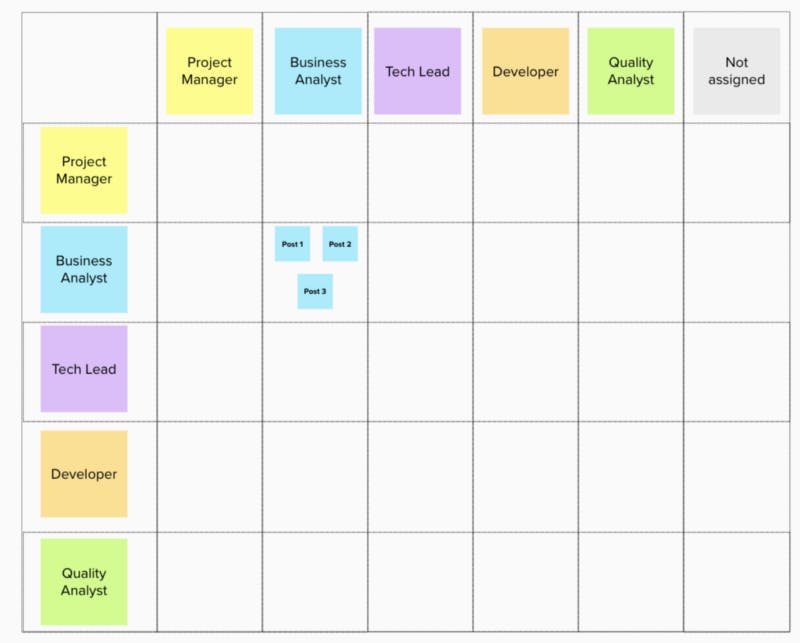This activity helps the team to better understand the role and responsibilities of each person. By specifying the expectations of each person on the team, everyone understands what needs to be done to achieve the team goals.
Source: aircall.io
Role and Responsibilities workshop brings together all the people on a team. During this activity, responsibilities are identified according to each role and the team has the same understanding about the different roles and responsibilities that exists on the team.
Roles are the positions that each person takes on the team — for example, in an agile development team, you can have the role of Product Manager, Developer, Business Analyst, etc.
Responsibilities, on the other hand, are specific tasks and commitments that are expected of people on the team who occupy a certain role.
This workshop promotes an alignment about expectations of each role and of the group. This exercise can be a good starting point when starting a new team or at times when the people on the team have changed.
In the preparation time, it's important to reserve a slot when all people of the team have time available and are able to participate actively in the workshop, without interruptions. It's important to have everyone engaged and committed with the agreements that will be set at the workshop.
Step 1: Activity introduction
Normally in the facilitations I focus on main 3 points: goal, expected outcome and time-box.
- Goal: to have alignment about roles and responsibilities
- Expected outcome: to define the responsibilities for each role and shared responsibilities of the team.
- Time-box: 1 hour and 30 minutes
Step 2: Roles identification
Define each roles that exist on the team, per exemple: Project Manager, Business Analyst, Developer, Tech Lead and Designer. Write them on the board that you have already prepared. I have created mine on Mural.

Step 3: Each person on the team identifies and writes down the responsibilities of their role
Time-box: 5 minutes
In this part, each person on the team has 5 minutes to write down the main activities for which they believe they are responsible in their own role. I suggest limiting the number of post-its in the maximum 5. The creation of these post-its can be done already in the column corresponding to the role of the person.
Step 4: Each person on the team identifies and writes down the responsibilities of other roles
Time-box: 5 minutes
In this step, the people on the team have 5 minutes to write 1 to 3 responsibilities that they believe are the main responsibilities of each of the other roles on the team. It's possible that at that moment, some responsibilities that were identified don't have a responsible person yet. In this case, the participants must already move the post-its to the “Unassigned” column. Reinforce the importance of listing this type of activity, because these activities can later be assigned to certain role.
Breaktime: 5 min
Step 5: Discussion about each role
Time-box: 10 minutes per role
Choose a person to start, for example the Business Analyst. Ask the Business Analyst to read what she has written as your top 3 priorities. Example below:

After this, ask each person on the team to read what was written as the top priorities for the team’s Business Analyst. In this part, the Business Analyst should agree with the proposals or refuse. In cases where there is no agreement between the team members of who should be doing such an activity, it's important that you as the facilitator, guide the discussions, asking for examples and converging the thoughts. This will help the team to match the responsibility with the role that should be assigned, or even agree that the location responsibility should be placed in the “Unassigned” column.
For all roles, it's necessary to repeat the same exercise mentioned above. I've reserved 10 minutes for each role to be discussed, it may take less than that, but it's important to allow enough time for the discussions to be effective.
After discussing and agreeing on the responsibilities for each role, the group will align expectations and identify those responsible for the activities in the “Unassigned” column. Also, take a maximum of 10 minutes to finish discussing this column.
At this point, the facilitator can read the activities and facilitate the discussion with the group so that the main person responsible for the activities can be identified.
Workshop summary and next steps
At the end of the exercise, summarize the roles and main responsibilities to ensure that everyone on the team is ok to move on with that. As next steps, it's interesting to align with the team how these role assignments will be followed. I suggest scheduling a review of these roles from time to time, especially when there are changes in the team, such as people leaving or entering.
If you made it this far, thank you and I hope this article has encouraged you to run this workshop with your team. Any feedbacks, please let me know! :)

